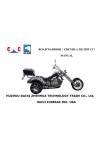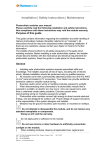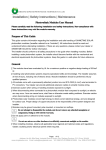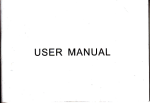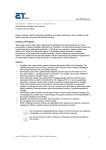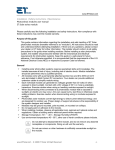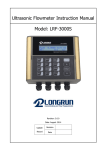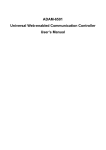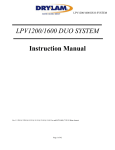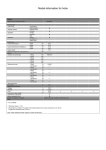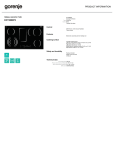Download Installation Safety Instructions Maintenance Manual Shandong
Transcript
Shandong Hilight-Solar Co.,Ltd Installation Safety Instructions Maintenance Manual Shandong Hilight-solar Co.,Ltd Preparing 2011 Shandong Hilight-Solar Co.,Ltd Installation | Safety instructions | Maintenance Photovoltaic modules user manual Please carefully read the following installation and safety instructions. Non-compliance with these instructions may void the module warranty. Purpose of this guide This guide contains information regarding the installation and safe handling of Hilight-solar photovoltaic modules (hereafter referred to as "modules"). All instructions should be read and understood before attempting installation. If there are any questions, please contact your dealer or Hilight-solar for further information. The installer should conform to all safety precautions in the guide when installing modules.Before installing a solar photovoltaic system,the installer should become familiar with the mechanical and electrical requirements for photovoltaic systems. Keep this guide in a safe place for future reference. General Installing solar photovoltaic systems requires specialized skills and knowledge. The installer assumes all risk of injury, including risk of electric shock. Module installation should be performed only by qualified persons. All modules come with a permanently attached junction box and #12 AWG (4 mm2) wire terminated in PV connectors. Exercise caution when wiring or handling modules exposed to sunlight. When disconnecting wires connected to a photovoltaic module that is exposed to sunlight, an electric arc may occur. Arcs can cause burns, start fires or otherwise create safety problems. Exercise caution when disconnecting wiring on modules exposed to sunlight. Photovoltaic solar modules convert light energy to direct-current electrical energy, and are designed for outdoor use. Proper design of support structures is the responsibility of the system designer and installer. Modules may be ground mounted, pole mounted, or mounted on rooftops. Do not attempt to disassemble the module, and do not remove any attached nameplates or components. Doing so will void the warranty. Do not apply paint or adhesive to the module. Shandong Hilight-Solar Co.,Ltd Do not use mirrors or other hardware to artificially concentrate sunlight on the module. When installing modules, observe all applicable local, regional and national codes and regulations. Obtain a building and/or electrical permit where required. Safety precautions for installing a solar photovoltaic system Solar modules produce electrical energy when exposed to sunlight. Only connect modules with the same rated output current in series. If modules are connected in series, the total voltage is equal to the sum of the individual module voltages. Only connect modules or series combinations of modules with the same voltage in parallel. If modules are connected in parallel, the number of parallel module = 1 + I( Max. over-current rating)/ Isc( short current) Keep children well away from the system while transporting and installing mechanical and electrical components. Completely cover all modules with an opaque material during installation to prevent electricity from being generated. Do not wear metallic rings, watchbands, ear, nose, or lip rings or other metallic devices while installing or troubleshooting photovoltaic systems. Use appropriate safety equipment (insulated tools,insulating gloves,etc) approved for use on electrical installations. Observe the instructions and safety precautions for all other components used in the system, including wiring and cables, connectors, DC-breakers, mounting hardware, inverters, etc. Use only equipment, connectors, wiring and mounting hardware suitable for use in a photovoltaic system. Always use the same type of module within a particular photovoltaic system. Under normal operating conditions, PV modules will produce currents and voltages that are different than those listed in the date sheet. Data sheet values are applicable at standard test data. Short-circuit current and open-circuit voltages should be multiplied by a factor of 1.25 when determining component voltage ratings, conductor ampacity, fuse sizes and size of controls connected to the module or system output.Refer to Section 690-8 of the National Electrical Code (NEC) for an additional multiplying factor of 125 percent (80 percent de-rating) which may be applicable. Shandong Hilight-Solar Co.,Ltd General installation notes Drainage holes must not be covered with parts of the mounting system. The junction box has a breather port which must be mounted facing downward and cannot be exposed to the rain. The junction box should be on the higher side of the module when it is mounted in order to orient the breather port correctly. Do not lift the module by grasping the module's junction box or electrical leads. Do not stand or step on module. Do not drop the module or allow objects to fall on the module. Do not place any heavy objects on the module. Inappropriate transport and installation may damage the module glass or frame. Mechanical Installation Selecting the location Select a suitable location for installation of the module. For optimum performance, the module must be facing true south in northern latitudes and true north in southern latitudes. For detailed information on optimal module orientation, refer to standard solar photovoltaic installation guides or a reputable solar installer or systems integrator. The module should not be shaded at any time of the day. Do not install the module near equipment or in locations where flammable gases can be generated or collected. Selecting the proper mounting structure and hardware Observe all instructions and safety precautions included with the mounting system to be used with the module. Do not drill holes in the glass surface of the module. Doing so will void the warranty. Do not drill additional mounting holes in the module frame. Doing so will void the warranty. Modules must be securely attached to the mounting structure using 8 mounting points for normal installation. Shandong Hilight-Solar Co.,Ltd Load calculations are the responsibility of the system designer or installer. The mounting structure and hardware must be made of durable, corrosion- and UV-resistant material. Mounting methods 1. Mounting with Bolts The module must be attached and supported by 8 bolts(M8) through the indicated mounting holes. The modules have been evaluated by UL for a maximum positive or negative design loading of 30 lbs/ft2. 2.Mounting solar modules with bracket on flat roof and ground Fasten bracket on flat roof or ground first, fasten solar modules on bracket, use nuts to fasten bracket. The bracket would endure 20 years, and is made of anticorrosive material. Temperature zinc steels and Stainless steel is recommended. The bracket should be solid enough to resist continuous load pressure from wind ,snow, earthquake and other outside force. Use insulation materials to isolate different metal like stainless steel, aluminum. This would prevent corrosion. Shandong Hilight-Solar Co.,Ltd insert screw into flat gasket insert screw into installation hole both onthe modules and supporting frame insert screw into flat gasket and spring gasket, then apply nut on the screw fasten it. refer to the following form for supporting bracket's slope angle 3. Other The recommended standoff height is 5 cm. If other mounting means are employed this may affect Shandong Hilight-Solar Co.,Ltd the UL Listing. Direction of module installation: PV module are rectangle shaped; PV module array longitudinal installation (the way that installs the module by long side longitudinal) is mostly used because the transverse installation (the way that installs the module by long side transversely) has less rain cleaning ability. For distance between the modules, longitudinal distance (along the roof gradient) should be enough for installation and disassembly; transverse distance should be 3-10cm. Other mounting methods are acceptable as long as the minimum requirements as described above. Above requirements are only basic instructions. For example, on slant roof ,Mono-crystalline Cell Module ,Poly-crystalline Cell Module Accessory: 1. Hexagon Self-locking Bolt M8*35 2. Hexagon Nut M10 Shandong Hilight-Solar Co.,Ltd 3. Spring Washer M10 4. Flat Washers M10 5.Nonstandard Nut M10 6. Nonstandard Bolt M10 Shandong Hilight-Solar Co.,Ltd 7. Pressure Plate 8 .Crossbeam 9. Crossbeam Foundation Shandong Hilight-Solar Co.,Ltd Electrical Installation Grounding There is the grounding hole and grounding marking along either edge of the frame indicating a ground bonding location. All module frames must be properly grounded. All bolts, nuts, washers are stainless-steel. Observe all local electric codes and regulations. Use solid uninsulated copper wire sizes 10 or 12 AWG. The wire must have no nick. Make the grounding wire connect to the bolt and tighten it. Put M4 stainless steel bolt across M4stainless steel spring washer, M4stainless steel flat washer, 2 pc of stainless steel cupped washer with a diameter of 4 Copper wire is winded on the bolt between two cupped washers. and M4 stainless steel star washer, and then through the grounding hole on the aluminum frame components, M4 stainless steel flat washer And spring washer, at last tighten them with the stainless steel M4 nut. (TORQUE 4N.M ) Details for wiring in accordance with the NEC, and that the grounding method of the frame of arrays shall comply with the NEC, article 250. General electrical installation Shandong Hilight-Solar Co.,Ltd Do not use modules of different configurations in the same system. This module is supplied with Multi Contact connectors for electrical connections. Refer to Section 690.31 of the NEC to determine appropriate types and temperature ratings of conductors. Wiring should be #12 AWG, 4 mm2 (minimum) and must be temperature rated at 90 °C (minimum). Completely cover system modules with an opaque material to prevent electricity from being generated while disconnecting conductors. Refer to Sections 690.8 and 310 of the NEC to determine overcurrent, Conductor ampacity and size requirements. In Canada, installation shall be in accordance with CSA C22.1, Safety Standard for Electrical Installations, Canadian Electrical Code, Part 1. For best performance, ensure that positive and negative DC wires run closely together avoiding loops. Application class is class A. Modules rated for use in this application class may be used in systems operating at greater than 50V DC or 240W, where general contact access is anticipated. Modules qualified for safety through this part of IEC61730 and IEC61730-2 and within this application class are considered to meet the requirements for safety class Ⅱ. Under normal conditions, a photovoltaic module is likely to experience conditions that produce more current and/or voltage than reported at standard test conditions. Accordingly, the value of Isc and Voc marked on this module should be multiplied by of 1.25 when determining component voltage ratings, conductor current ratings, fuse sizes, and size of controls connected to the PV output. Artificially concentrated sunlight shall not be directly on the module. PV model and production date can be checked from the sequence number. PV sequence encoding rules: PV sequence number content: company code, power, year, month and date of production, batch number, Sequence number production. For example: HSPV29020110905010019. HS is for company code, 290 Wp for PV power, 20110905 stand for production date,September 5, 2011, 01 for production first batch, 0019 for production sequence number. In systems with more than two modules in series, high reverse current can flow through cells that are shaded partially or outright when part of a module is shaded and the rest is exposed to the sun. These currents can cause the affected cells to get very hot and could even damage the module. To protect module from such high reverse currents, by-pass diodes are used in module. In the unlikely Shandong Hilight-Solar Co.,Ltd event of diode failure, we recommend a qualified service technician be employed to determine if diodes have failed and to make replacement. Junction box The offers two types of junction box: the wiring type box and the integrated box. When integrated J-box is adopted, no tool is necessary for wiring . Just connect modules in series according to “+” or “-” . You can complete complex series and parallel connection easily and quickly using different electric connectors provided by supplier. Connectors provided by different suppliers will not mutual match up. Different connectors provided by one supplier will not match up either. Only one type of the same connector from one supplier shall be used to ensure the reliability of electrical connection. The terminals and the diodes of the integrated J-box are sealed in silicon rubber hermetically for waterproofing and safety. Do not attempt to open the sealed structure. There are more options by using wiring type junction box which consists of two terminals marked with "+" and "-" to representing the positive and negative terminals of the power supply. Some of junction boxes include three or more terminals. Only those terminals indicated with "+" and "-" should be connected to the load. Others are designed for the bypass diodes to reduce the damages of modules caused by hot spot and to ensure undisrupted electrical energy output from array. Wiring can only be completed by qualified engineer with suitable tools. The hex nut in the position of exit of junction box is used to hold rubber ring to seal the box. The specification of wire for electric coupler that we provided is 12 AWG. Equivalent wire should be used if the user prefers to use its own wire. When the module’s rated current is lower, 14 AWG wire is recommended for use and the strength of wire should be taken into consideration. In order to improve sealed effect of the J-box, there is a layer of silicon grease between the box and its cover. After re-wiring, it is necessary to put a layer of silicon grease again. The modules are designed to use copper wire only. If a flexible copper wire is chosen for use, a pipe form terminal crimp is necessary. In this way, the wire tip can be pressed unfailingly. The working temperature of wire and J-box is –40℃-90℃. WARNING! Electrical shock hazard! Do not touch bare conductors or other potentially energized parts. Maintenance HILIGHT-SOLAR recommends the following maintenance items to ensure optimum performance of the module: Clean the glass surface of the module as necessary. Use water and a soft sponge or cloth for cleaning. A mild, non-abrasive cleaning agent can be used if necessary. Do not use dishwasher detergent. Electrical and mechanical connections should be checked periodically by qualified personnel to verify that they are clean, secure and undamaged. Check the electrical and mechanical connections periodically to verify that they are clean, secure Shandong Hilight-Solar Co.,Ltd and undamaged. Problems should only be investigated by qualified personnel. Observe the maintenance instructions for all other components used in the system. Artificially concentrated sunlight shall not be directed on the module. Shutting down the syste Completely cover system modules with an opaque material to prevent electricity from being generated while disconnecting conductors. Disconnect system from all power sources in accordance with instructions for all other components used in the system. The system should now be out of operation and can be dismantled. In doing so, observe the all safety instructions as applicable to installation. Electrical ratings of the concerned modules: The electrical characteristics are within ±10 % of the indicated values of ISC, VOC, and Pmax under Standard Test Conditions (irradiance of 1000 W/m2, AM 1.5 spectrum, and a cell temperature of 25°C/77°F). Disclaimer of liability Because the use of this manual and the conditions or methods of installation, Operation, use and maintenance of photovoltaic products are beyond control; Hilight-solar does not accept responsibility and expressly disclaims liability for loss, damage, or expense arising out of or in any way connected with such installation, operation, use or maintenance. No responsibility is assumed by Hilight-solar for any infringement of patents or other rights of third parties, which may result from use of the PV product. No license is granted by implication or otherwise under any patent or patent rights. The information in this manual is based on Hilight-solar's knowledge and experience and is believed to be reliable, but such information including product specification (without limitations) and suggestions does not constitute a warranty, expressed or implied. Hilight-solar reserves the right to change the manual, the product, the specifications, or product information sheets without prior notice. Shandong Hilight-Solar Co.,Ltd Manufacturer: Shandong Hilight-solar Co.,LTD ADD: Mazhuang Country, Daixi Office ,Zouping couty ,Binzhou city Shandong 256200 P.R. China Please consult your dealer or the manufacturer concerning the warranty of your modules. If you have any further questions, your dealer will gladly assist you. Subject to technical modifications without notice.














